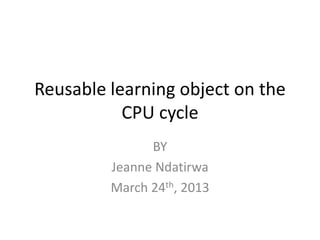
The cpu cycle
- 1. Reusable learning object on the CPU cycle BY Jeanne Ndatirwa March 24th, 2013
- 2. Introduction • The CPU which is often described as the “brain of the computer”. • Most CPUs are collections of digital circuits imprinted on silicon wafers, or chips, no bigger than the tip of a pencil eraser. • The increased speed the current in a CPUS travels at, can be increased by reducing the distance between points which has resulted in ever smaller chips (see Moore’s Law). • The CPU cycle is closely associated with primary storage also known as main memory.
- 3. Purpose of the CPU • The job of the CPU is to execute programs • A program is a list of unambiguous instructions designed to be followed mechanically by a computer. • Once the CPU executes a program, it is stored in a computer’s main memory (RAM or random access memory). • The CPU can also store information in memory by specifying the information to be stored and the address of the location where it is to be stored.
- 4. Hardware Components The CPU consists of three elements: The arithmetic/logic unit (ALU): performs mathematical calculations and makes logical comparisons. The control unit: sequentially accesses program instructions, decodes them, and coordinates the flow of data in and out of the ALU. Registers (storage area): are high-speed storage areas used to temporarily hold small units of program instructions and data immediately before, during, and after execution by the CPU.
- 5. Components in action Executing any machine-level instruction involves two phases: instruction and execution. The instruction phase consists of: 1. Fetch instruction: the computer reads the next program instruction to be executed and any necessary data into the processor. 2. Decode instruction: instruction is decoded and passed to the appropriate processor execution unit. The time it takes to perform the instruction phase is called the instruction time (I-time).
- 6. Components in action The execution phase consists of 3. Execute instruction: hardware element, freshly fed with an instruction and data, carries out the instruction. 4. Store results: results are stored in registers The time it takes to complete the execution phase is called the execution time (E-time).
- 7. Processing
- 8. Processing Fetch Instructions from Memory Execute Decode ALU Control Unit
- 9. Processing Various measures are used to gauge processing speed: 1. Machine cycle time: measured by how many instructions are executed in one second, also measured in nanoseconds or picoseconds. 2. Clock Speed: series of electronic pulses produced at a predetermined rate that affects machine cycle, measured in mega or gigahertz.
- 10. Processing Multiprocessing: involves the simultaneous execution of two or more instructions at the same time. Coprocessor: the part of the computer that speeds processing by executing specific types of instructions while the CPU works on another processing activity. Multicore Microprocessor: a processor that combines two or more independent processors into a single computer as they share the workload. Parallel Computing: simultaneous execution of the same task on multiple processors to obtain results faster. Grid Computing: use of a collection of computers , usually owned by multiple individuals or organizations to work in a coordinated manner to solve a common problem.
- 11. Memory characteristics and function Main memory provides the CPU with a working storage area for programs and data. Computer memory takes several forms: • Random access memory (RAM): a form of memory in which instructions or data can be temporarily stored. • Ready-only memory (ROM): a non-volatile form of memory. • Cache memory: a type of high-speed memory that a processor can access more rapidly than main memory.
- 13. Credits • http://www.teach- ict.com/gcse_computing/ocr/212_computing_hardware/cpu/ miniweb/pg2.htm • http://math.hws.edu/javanotes/c1/s1.html • http://www.teach- ict.com/gcse_computing/ocr/212_computing_hardware/cpu/ quiz/penalty_cpu.htm • Stair, R. & Reynolds, G “Principles of information systems”, 10th ed., pp. 91-97.